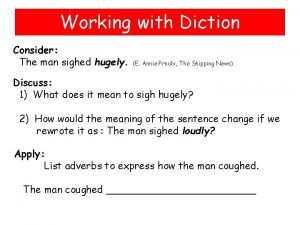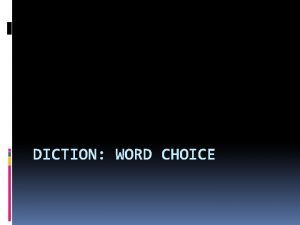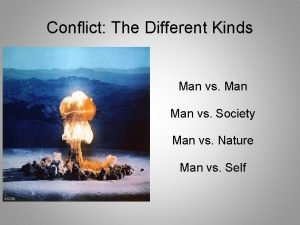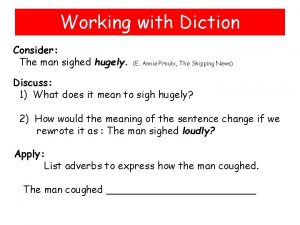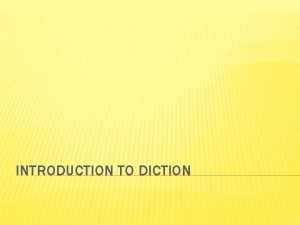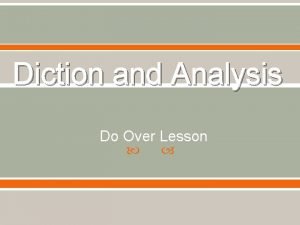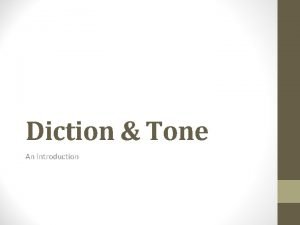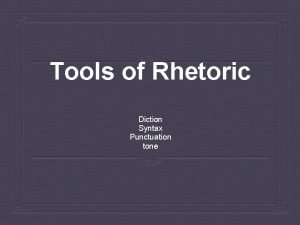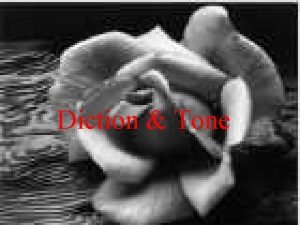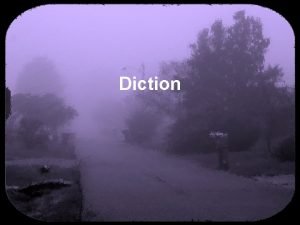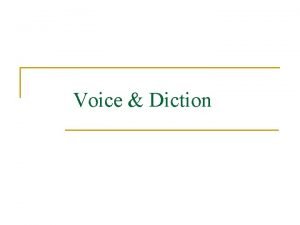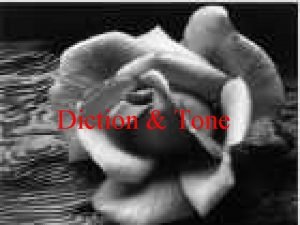Working with Diction Consider The man sighed hugely

















- Slides: 17

Working with Diction Consider: The man sighed hugely. (E. Annie Proulx, The Shipping News) Discuss: 1) What does it mean to sigh hugely? 2) How would the meaning of the sentence change if we rewrote it as : The man sighed loudly? Apply: List adverbs to express how the man coughed. The man coughed ____________

Meaning: Examples: Usable Edibile Class Examples: Visual/Memory Clue 30 -15 -10 List Suffix Meaning -able, -ible Able to (adj) Suffix: -er, -or One who does (N) -able -ible -fy To make (v) -ism The practice of (N) -ist One who is occupied with (N)

Meaning: Examples: Amplify Villify Examples: Competitor Senator Class Examples: Visual/Memory Clue Suffix: -er -or Suffix: -fy Class Examples: Visual/Memory Clue

Meaning: Examples: Pacifist Feminist Examples: Racism Rationalism Suffix: Class Examples: Visual/Memory Clue -ism Suffix: -ist Class Examples: Visual/Memory Clue

AP MC Test 1) Compare & Discuss answers 2) Record “new” discussed answers on answer sheet given today 3) Score both (your original & the new discussed) 4) Access your strengths and weaknesses

AP Test Strengths & Weaknesses Strengths Weaknesses

Working with Diction II Consider: A rowan* like a lipsticked girl. (Seamus Heaney, “Song, ” Field Work) * a small tree with white flower clusters & orange berries. Discuss: 1) Other than color, what comes to mind when you think of a lipsticked girl? 2) How would it change the meaning and feeling of the line if, instead of lipsticked girl, the author wrote girl with lipstick on? Apply: Create a simile comparing a tree to an animal. In your simile, use a word that is normally used as a noun (like lipstick) as an adjective (like lipsticked).

The Glass Castle 1) Part 5 Due tomorrow 2) Share Scene Swaps tomorrow 3) Socratic-type discussion of the novel tomorrow End of the hour: • Develop three open ended questions about any aspect of the novel. • Record on Index Card

Working with Syntax Consider: The seven years’ difference in our ages lay between us like a chasm: I wondered if these years would ever operate between us as a bridge. (James Baldwin, “Sonny’s Blues”) Discuss: . 1) What function does the colon serve in the sentence? 2) How would the meaning and the impact of the sentence change if the sentence read as follows: Apply: The seven years’ difference in our ages lay between us like a chasm, and I wondered if these years would ever operate between us as a bridge. Write two independent clauses; join the two with a colon, giving emphasis to the IC that follows the colon. Use Baldwin’s sentence as a model.

The Glass Castle 1) Part 5 Due 2) Share Scene Swaps 3) Socratic-type discussion of the novel

Working with Tone Consider: Look over the grid below and with a partner, say each “right” out loud, emphasizing the attitude each suggests. Right? Is this right? Right! You’re absolutely right. . Right! This won’t happen. Right. I heard you, but I don’t believe you. Right! Turn right, not left! Apply: with your partner, create a similar chart, but for a different word that can have the same conveyance of attitude. . Remember: Tone is more than what is said, it’s how it is said. We create tone in writing through the elements of voice: Diction, Imagery, Detail, Syntax….

Analysis Acronym Example Speaker Occasion Audience Purpose Subject Speaker, Occasion, & Subject 1) (Writer’s Credentials), (writer’s first and last name), in his/her (type of text), (title of text), (strong verb), (writer’s subject). Purpose 2) (Writer’s last name)’s purpose is to (what the writer does in the text). Audience 3) He/she adopts a (adjective describing the attitude/feeling conveyed by the writer) tone in order to (verb phrase describing what the writer wants reader to do/think) in his/her (intended audience). The Glass Castle Intro Rhetorical Precis:

The Glass Castle RA: Divide & Conquer Get out your work from The Glass Castle parts 1 -5 Count off by 5’s (you will be working alone) 1’s = Write the 1 st body paragraph about part 1 & DIDST grid 2’s = Write the 2 nd body paragraph about part 2 & DIDST grid 3’s = Write the 3 rd body paragraph about part 3 & DIDST grid 4’s = Write the 4 th body paragraph about part 4 & DIDST grid 5’s = Write the 5 th body paragraph about part 5

Analysis Acronym Example Diction (logos, pathos, ethos) Imagery (logos, pathos) Detail (logos, pathos) Syntax Tone (logos, pathos, ethos) 1) Sentence one: Identify section of text & main idea of section (Writer’s last name) (transition word) his/her (type of text) by (strong verb) that (main idea of that section). 2) Sentence two: Conveys the writer’s support for the main idea by identifying and providing a specific example for one rhetorical strategy used by the writer. (Repeat if you want to discuss more than one rhetorical strategy) 3) Sentence three: Explains how the rhetorical strategies you discussed in the previous sentences help the writer achieve his purpose by using and in order to statement. 4) Sentence four: Identifies the effect of the writer’s use of these rhetorical strategies on the audience. The Glass Castle body paragraph(s):

Happy Friday! Get ready for your quiz: Suffix Meaning -able, -ible Able to (adj) -er, -or One who does (N) -fy To make (v) -ism The practice of (N) -ist One who is occupied with (N)

The Glass Castle: Class RA • Go over the selected sample paragraphs for each section of TGC • Circle the “best” of each section; discuss • Copy & paste “Essay” (intro & all 5 body para’s) FINALLY: Write the conclusion (follow template) & turn-in

Analysis Acronym Example Speaker, Occasion, Subject Audience, Purpose DIDST Why it matters… 1) Sentence one: Briefly restate your main argument (Writer’s Credentials), (writer’s first and last name), in his/her (type of text), (title of text), (strong verb), (writer’s subject) in order to (purpose) (effect on audience). 2) Sentence two: How the rhetorical choices of the author influence the delivery of the message. (Writer’s last name) use of (rhetorical strategies) allows him/her to (adverb)(strong verb) (the message/purpose). 3) Sentence three: Why it matters/real world indications/underlying message. The Glass Castle Conclusion:
 The man sighed loudly meaning
The man sighed loudly meaning The man coughed adverb
The man coughed adverb Diction vs connotation
Diction vs connotation Whats man vs society
Whats man vs society Hard work and smart work
Hard work and smart work Contoh hot working
Contoh hot working Cold working of metals
Cold working of metals Hot working and cold working difference
Hot working and cold working difference Machining operations
Machining operations Phản ứng thế ankan
Phản ứng thế ankan Các môn thể thao bắt đầu bằng tiếng nhảy
Các môn thể thao bắt đầu bằng tiếng nhảy Thiếu nhi thế giới liên hoan
Thiếu nhi thế giới liên hoan Sự nuôi và dạy con của hươu
Sự nuôi và dạy con của hươu điện thế nghỉ
điện thế nghỉ Một số thể thơ truyền thống
Một số thể thơ truyền thống Biện pháp chống mỏi cơ
Biện pháp chống mỏi cơ Trời xanh đây là của chúng ta thể thơ
Trời xanh đây là của chúng ta thể thơ Các số nguyên tố là gì
Các số nguyên tố là gì
